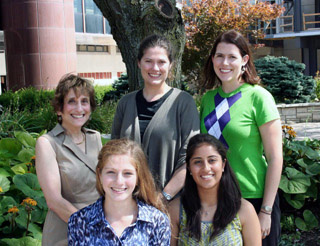
Front: Hockaday students Emily Wechsler and Shreya Ahuja. Back: Barbara Fishel, Hockaday Dean of Studies; Melissa Duff, faculty member in the Interdisciplinary Graduate Program in Neuroscience; and Katie Croft, UI alumna and Hockday science teacher. Photo by John Riehl.
With 100 billion nerve cells interconnected via a vast network of neural pathways, the complexity of the human brain is awe-inspiring.
Your brain serves as command center for your body’s vital functions, houses your future hopes and cherished memories, and serves as the seat of consciousness through which you draw purpose and passion.
Shreya Ahuja marvels at how the human brain executes these countless functions, especially after holding one in her hands.
“It was a lot lighter than I thought it would be,” Ahuja says. “For the number of capabilities the brain has, it is pretty amazing it only weighs three pounds.”
Ahuja and Emily Wechsler, 16-year-old high school students at The Hockaday School in Dallas, received an intensive two-week introduction to neuroscience at the University of Iowa last July. Melissa Duff, faculty member in the UI’s Interdisciplinary Graduate Program in Neuroscience, hosted the students in her laboratory as part of this pilot program. Duff holds a faculty appointment in Communication Sciences and Disorders in the College of Liberal Arts and Sciences.
The Hockaday School—an independent college preparatory day and boarding school for girls—has established an informal partnership with the UI allowing its students to gain summer research experience in UI laboratories. The relationship between the two schools was initiated by Hockaday science teacher Katie Croft, who earned her doctorate in neuroscience at the UI in 2009.
“Melissa is a perfect choice to work with. Her research is cutting edge, very accessible, and very interdisciplinary,” Croft says. “She’s had lots of experience mentoring students with all different abilities. Furthermore, she’s a perfect role model of a young, successful female scientist. I want our students to have an appreciation for science and feel like they have a good understanding of the real scientific process, which is best taught by doing it.”
Duff, who was a postdoctoral scholar in neurology at the UI when Croft was a graduate student, enjoyed introducing the young women to the world of neuroscience.
While at the UI, the students gained hands-on experience working alongside Duff. The students observed patients with neurological disease, read basic neuroscience research papers, assisted on a project in Duff’s lab, and learned more about traumatic brain injury.
“I’ve never mentored 16-year-old ladies, so I was intrigued about how this research experience would look for younger women,” says Duff, director of the Iowa Traumatic Brain Injury Registry. “As a woman in science and the mother of a little girl, it was fantastic. We talked a lot about the science process, the experience of going to graduate school, and what careers in science look like.”
Ahuja and Wechsler presented a poster about their Iowa experience at the Society for Neuroscience’s 2012 annual meeting in New Orleans in October. Their presentation was part of the conference session Teaching of Neuroscience: K-12.
“The poster focused on what we learned and the partnership between The Hockaday School and the UI,” Ahuja says. “It also was about how we plan to carry this experience to Hockaday.”
Both students agreed that the most valuable aspect of their research experience at Iowa was the people.
“We talked to graduate students, Ph.D.s, undergraduates,” Ahuja says. “Picking up on those conversations throughout the two weeks expanded our knowledge tenfold.”
“The most important thing we did was talk to all different people. They’re who made this experience great,” Wechsler says. “This was probably the coolest thing I’ve ever done. Being here and doing the things we did probably has changed what I will do later on in life. Now, I might do neuroscience because I absolutely love it.”
Barbara Fishel, dean of studies and director of the Hockaday Research Program, wants Hockadaystudents to participate in authentic scientific investigation, and says the UI is a great place for that to happen.
“(In our research program), we’ve seen a maturing in our girls’ scientific reasoning and understanding of the process of science, which enriches their learning experience,” Fishel says. “We would like to make this partnership a formal partnership. This has potential to be a flourishing long-term model for us.”
In addition to presenting a poster at the Society for Neuroscience’s annual meeting, Ahuja wrote an essay about traumatic brain injury for the International Science Essay Competition at Dartmouth College.
Ahuja’s entry—“Humpty Dumpty without the King’s Men”—placed second out of more than 80 submissions from more than 20 countries and has been selected for publication in the Dartmouth Undergraduate Journal of Science.
In her essay, she calls for more researchers, funding, and awareness to be given to patients with traumatic brain injury—an “invisible” condition that is complicated to diagnose and treat. The essay was inspired by the two weeks studying neuroscience at the UI.
“I wanted to go into medicine, and I had been leaning toward surgery,” Ahuja says. “When I came to the University of Iowa, I knew nothing about neuroscience. This experience opened up a whole new world of research. Now, there are so many more possibilities for me to look at.”
Those words bring a smile to Duff’s face.
“What’s exciting about this partnership is the mission of The Hockaday School to give young women opportunities in science, coupled with the investment to make neuroscience more accessible and more attractive to younger and younger people,” Duff says.